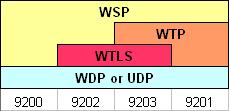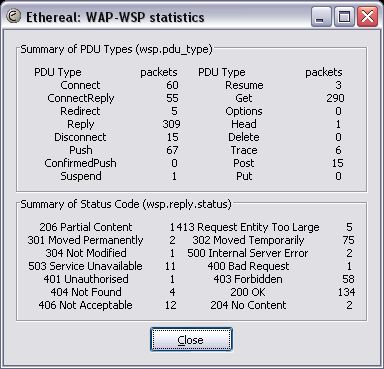Wireless Session Protocol (WSP)
The Wireless Session Protocol offers the HTTP request-response paradigm, and in addition it offers a new service named Wap Push, allowing applications in the network to push (unsolicited) data to a push-enabled application on the mobile device.
The Wireless Session Protocol started with the knowledge that many header names and values in the Hyper_Text_Transfer_Protocol are fixed strings. With efficient over-the-air usage of the bandwidth in mind, WSP attempts at encoding these fixed strings in a compact binary manner. This way, the header cache-control: no-cache can be encoded in 2 bytes: one for the header name (cache-control) and one for its value (no-cache).
There are 2 types of WSP:
-
Connectionless WSP (CL-WSP) only offers unreliable transport of WSP primitives, both pull (request and response) and push (single message).
-
Conection-oriented WSP (CO-WSP) offers the same services as CL-WSP, extended with connection (session) management, session capability negotiation, larger data transfer (segmentation and reassembly) and reliable data transport (acknowledgement mechanism).
On a protocol level, CO-WSP relies upon WTP for the added functionality. With CL-WSP, the WTP layer is reduced to a one-byte transaction identifier, which is part of WSP as the 1st byte. This way it is still possible in WTP to match a response with a request (same WSP transaction identifier).
History
In the early days of mobile Internet (access to Internet-like network services with a handheld device on a wireless network), it was already understood that bandwidth was a costly resource, and that round-trips were typically significantly longer than on classic computer networks. Both yielded an efficient protocol family created at the WAP Forum. The WAP Forum defined a protocol family for enabling Internet-like and Internet-based serviced to be accessible on mobile devices with limited capabilities and resources, being part of a wireless network.
One of the goals of the WAP Forum was to define a set of protocols which could offer Hyper_Text_Transfer_Protocol like transport in a more efficient manner. This resulted in the Wireless Session Protocol (WSP).
Protocol dependencies
The WAP transport protocol stack is shown below:
Depending on the protocol stack, 4 different standard WDP (UDP) ports have been defined: 9200, 9201, 9202 and 9203. WSP can run on other ports too.
-
WDP: On non-IP bearers, WSP uses WDP as its transport protocol.
-
UDP: On IP-enabled bearers (such as GPRS and GSM CSD) WSP uses UDP as its transport protocol.
-
WTLS: If the bearer does not provide security, WSP often uses WTLS for over-the-air encryption to prevent eavesdropping.
-
WTP: When WTP is used, we're talking about Connection-Oriented WSP (CO-WSP), where WTP provides WSP connection (session) management, session capability negotiation, larger data transfer (segmentation and reassembly, WTP SAR) and reliable data transport (acknowledgement mechanism).
Example traffic
No. Time Source Destination Protocol
669 193.049760 10.0.1.5 10.0.1.204 SMPP
Info
WSP Push (0x06) (WBXML 1.2, Public ID: "-//WAPFORUM//DTD SI 1.0//EN (Service Indication 1.0)")
Frame 669 (191 bytes on wire, 191 bytes captured)
Arrival Time: Jan 7, 2005 11:11:29.444839000
Time delta from previous packet: 193.049760000 seconds
Time since reference or first frame: 193.049760000 seconds
Frame Number: 669
Packet Length: 191 bytes
Capture Length: 191 bytes
Ethernet II, Src: 00:0b:cd:31:a1:2b, Dst: 00:40:f4:61:36:52
Destination: 00:40:f4:61:36:52 (CameoCom_61:36:52)
Source: 00:0b:cd:31:a1:2b (CompaqHp_31:a1:2b)
Type: IP (0x0800)
Internet Protocol, Src Addr: 10.0.1.5 (10.0.1.5), Dst Addr: 10.0.1.204 (10.0.1.204)
Version: 4
Header length: 20 bytes
Differentiated Services Field: 0x00 (DSCP 0x00: Default; ECN: 0x00)
0000 00.. = Differentiated Services Codepoint: Default (0x00)
.... ..0. = ECN-Capable Transport (ECT): 0
.... ...0 = ECN-CE: 0
Total Length: 177
Identification: 0x01a1 (417)
Flags: 0x04 (Don't Fragment)
0... = Reserved bit: Not set
.1.. = Don't fragment: Set
..0. = More fragments: Not set
Fragment offset: 0
Time to live: 128
Protocol: TCP (0x06)
Header checksum: 0xe1d5 (correct)
Source: 10.0.1.5 (10.0.1.5)
Destination: 10.0.1.204 (10.0.1.204)
Transmission Control Protocol, Src Port: 1054 (1054), Dst Port: 10001 (10001),
Seq: 48, Ack: 48, Len: 137
Source port: 1054 (1054)
Destination port: 10001 (10001)
Sequence number: 48 (relative sequence number)
Next sequence number: 185 (relative sequence number)
Acknowledgement number: 48 (relative ack number)
Header length: 20 bytes
Flags: 0x0018 (PSH, ACK)
0... .... = Congestion Window Reduced (CWR): Not set
.0.. .... = ECN-Echo: Not set
..0. .... = Urgent: Not set
...1 .... = Acknowledgment: Set
.... 1... = Push: Set
.... .0.. = Reset: Not set
.... ..0. = Syn: Not set
.... ...0 = Fin: Not set
Window size: 64081
Checksum: 0x66e6 (correct)
Short Message Peer to Peer, Command: Submit_sm, Seq: 19, Len: 137
Length : 137
Operation : Submit_sm (0x00000004)
Sequence #: 19
Service type: (Default)
Type of number (originator): Unknown (0x00)
Numbering plan indicator (originator): ISDN (E163/E164) (0x01)
Type of number (recipient): National (0x02)
Numbering plan indicator (recipient): ISDN (E163/E164) (0x01)
Recipient address: 0123456789
.... ..00 = Messaging mode: Default SMSC mode (0x00)
..00 00.. = Message type : Default message type (0x00)
01.. .... = GSM features : UDHI indicator (0x01)
Protocol id.: 0x00
Priority level: GSM: None ANSI-136: Bulk IS-95: Normal (0x00)
Scheduled delivery time: Immediate delivery
Validity period: SMSC default validity period
.... ..00 = Delivery receipt : No SMSC delivery receipt requested (0x00)
.... 00.. = Message type : No recipient SME acknowledgement requested (0x00)
...0 .... = Intermediate notif: No intermediate notification requested (0x00)
.... ...0 = Replace : Don't replace (0x00)
Data coding: 0xf5
SMPP Data Coding Scheme: Unknown (0xf5)
GSM SMS Data Coding
1111 .... = DCS Coding Group for SMS: SMS DCS: Data coding / message class (0x0f)
.... 01.. = DCS Character set: 8-bit data (0x01)
.... ..01 = DCS Message class: Class 1 - ME specific (0x01)
GSM CBS Data Coding
1111 .... = DCS Coding Group for CBS: SMS DCS: Data coding / message class (0x0f)
.... 01.. = DCS Character set: 8-bit data (0x01)
.... ..01 = DCS CBS Message class: Class 1 - User defined (0x01)
Predefined message: 0
Message length: 94
Message
GSM Short Message Service User Data
UDH Length: 6
IE Id: SMS - Application port addressing scheme, 16 bit address (0x05):
source port 9200, destination port 2948
Destination port: 2948
Source port: 9200
Wireless Session Protocol, Method: Push (0x06), Content-Type: application/vnd.wap.sic
Transaction ID: 0xd0
PDU Type: Push (0x06)
Headers Length: 1
Content-Type: application/vnd.wap.sic
WAP Binary XML, Version: 1.2, Public ID: "-//WAPFORUM//DTD SI 1.0//EN (Service Indication 1.0)"
Version: 1.2 (0x02)
Public Identifier (known): -//WAPFORUM//DTD SI 1.0//EN (Service Indication 1.0) (0x00000005)
Character Set: utf-8 (0x0000006a)
String table: 0 bytes
Data representation
Level | State | Codepage | WBXML Token Description | Rendering
0 | Tag | T 0 | Known Tag 0x05 (.C) | <si>
1 | Tag | T 0 | Known Tag 0x06 (AC) | <indication
1 | Attr | A 0 | Known attrStart 0x0C | href='http://'
1 | Attr | A 0 | STR_I (Inline string) | 'src.miel.com/imags/
wallpapers/xmas.jpg'
1 | Attr | A 0 | Known attrStart 0x07 | action='signal-medium'
1 | Tag | T 0 | END (attribute list) | >
1 | Tag | T 0 | STR_I (Inline string) | 'Merry xmas !!!! JO JO JO'
1 | Tag | T 0 | END (Known Tag 0x06) | </indication>
0 | Tag | T 0 | END (Known Tag 0x05) | </si>Wireshark
The WSP dissector is fully functional, with the restriction that the Expect, Retry-After, Cookie and Set-Cookie headers are not yet decoded.
Wireshark also provides WSP statistics. Output looks like:
Preference Settings
There are no preferences for WSP in Wireshark.
Example capture file
SampleCaptures/wap_google.pcap
Display Filter
A complete list of WSP display filter fields can be found in the display filter reference
Show only the WSP based traffic:
wsp Capture Filter
You cannot directly filter WSP traffic while capturing. However, if you know the transport protocols used (see above), you can filter that way.
External links
- See the WAP Forum and the Open Mobile Alliance.
Discussion
Imported from https://wiki.wireshark.org/Wireless_Session_Protocol on 2020-08-11 23:27:34 UTC


